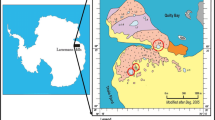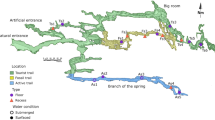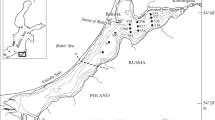Abstract
The paper discussed the influence of the forms of sediment accumulation on the surface of glaciers on their chemical and physicochemical properties. The materials sampled from the surface of five glaciers of the Svalbard Archipelago was analyzed. We studied such forms of sediment accumulation as dirt cones - the ice core covered with sediments and cryoconite holes - hollows on the glacier surface containing cryoconite material. Parameters such as total organic carbon content, microbiological activity, pH, the content of mobile forms of potassium and phosphorus, and concentrations of heavy and trace metals were studied. Also, mesomorphological studies were carried out and the polydisperse composition of the sediments was determined. According to the results of this work, it was found that the content of organic carbon in the material selected from dirt cones and cryoconite holes can be up to 2.5%, but the content of clay particles in it is mainly at the 10–15% level. Potassium concentrations are up to 250 mg/kg, and phosphorus is up to 800 mg/kg. The content of metals is typical or lower than in the previously published data. The main influence on the chemical composition of materials has a geographical factor of the sampling site, rather than the form of material accumulation.













Similar content being viewed by others
Data Availability
The reader can obtain the data of interest on request.
References
Abakumov E, Nizamutdinov T, Polyakov V (2021a) Analysis of the polydispersity of soil-like bodies in glacier environments by the laser light scattering (diffraction) method. Biol Commun 66:198–209
Abakumov E, Nizamutdinov T, Yaneva R, Zhiyanski M (2021b) Polycyclic aromatic hydrocarbons and potentially toxic elements in soils of the vicinity of the bulgarian Antarctic Station “St. Kliment Ohridski”(Antarctic Peninsula). Front Environ Sci 9:127
Abakumov E, Parnikoza IY, Zhianski M, Yaneva R, Lupachev A, Andreev M, Vlasov DY, Riano J, Jaramillo N (2021c) Ornithogenic factor of soil formation in Antarctica: a review. Eurasian Soil Sci 54:528–540
Abakumov E, Kushnov I, Nizamutdinov T, Tembotov R (2022) Cryoconites as biogeochemical markers of anthropogenic impact in high mountain regions: analysis of polyaromatic pollutants in soil-like bodies.One Ecosyst 7, e78028
Anesio AM, Hodson AJ, Fritz A, Psenner R, Sattler B (2009) High microbial activity on glaciers: importance to the global carbon cycle. Glob Change Biol 15:955–960
Baccolo G, Di Mauro B, Massabò D, Clemenza M, Nastasi M, Delmonte B, Prata M, Prati P, Previtali E, Maggi V (2017) Cryoconite as a temporary sink for anthropogenic species stored in glaciers. Sci Rep 7:9623
Bagshaw EA, Tranter M, Fountain AG, Welch KA, Basagic H, Lyons WB (2007) Biogeochemical evolution of cryoconite holes on Canada Glacier, Taylor Valley, Antarctica. Journal of Geophysical Research: Biogeosciences 112
Bagshaw EA, Tranter M, Fountain AG, Welch K, Basagic HJ, Lyons WB (2013) Do cryoconite holes have the potential to be significant sources of C, N, and P to downstream depauperate ecosystems of Taylor Valley, Antarctica? Arctic, Antarctic, and Alpine Res 45, 440–454
Beine HJ, Engardt M, Jaffe DA, Hov Ø, Holme K, Stordal F (1996) Measurements of NOx and aerosol particles at the NY-A lesund Zeppelin mountain station on Svalbard: influence of regional and local pollution sources. Atmos Environ 30:1067–1079
Belkina OA, Mavlyudov BR (2011) Mosses on the glaciers of Spitsbergen. Botanicheskii Zhurnal 96:582–596
Breen K, Lévesque E (2008) The influence of biological soil crusts on soil characteristics along a high Arctic glacier foreland, Nunavut, Canada. Arctic. Antarct Alp Res 40:287–297
Buda J, Łokas E, Pietryka M, Richter D, Magowski W, Iakovenko NS, Porazinska DL, Budzik T, Grabiec M, Grzesiak J, Klimaszyk P, Gaca P, Zawierucha K (2020) Biotope and biocenosis of cryoconite hole ecosystems on ecology glacier in the maritime antarctic. Sci Total Environ 724:138112
Cameron KA, Hodson AJ, Osborn AM (2012) Carbon and nitrogen biogeochemical cycling potentials of supraglacial cryoconite communities. Polar Biol 35:1375–1393
Chernov R, Muraviev AY (2018) Contemporary changes in the area of glaciers in the western part of the Nordenskjold Land (Svalbard). LED I SNEG-ICE AND SNOW 58, 462–472
Choudhary S, Nayak GN, Khare N (2020) Source, mobility, and bioavailability of metals in fjord sediments of Krossfjord-Kongsfjord system, Arctic, Svalbard. Environ Sci Pollut Res 27:15130–15148
Cook J, Edwards A, Takeuchi N, Irvine-Fynn T (2016) Cryoconite: the dark biological secret of the cryosphere. Prog Phys Geogr 40:66–111
Crocker RL, Dickson B (1957) Soil development on the recessional moraines of the Herbert and Mendenhall Glaciers, south-eastern Alaska. J Ecol,169–185
Dong Z, Qin D, Kang S, Liu Y, Li Y, Huang J, Qin X (2016) Individual particles of cryoconite deposited on the mountain glaciers of the Tibetan Plateau: insights into chemical composition and sources. Atmos Environ 138:114–124
Drbal K, Elster J, Komarek J (1992) Heavy metals in water, ice and biological material from Spitsbergen, Svalbard. Polar Res 11:99–101
Edwards A, Irvine-Fynn T, Mitchell AC, Rassner SM (2014) A germ theory for glacial systems? Wiley Interdiscipl Rev: Water 1:331–340
Elagina N, Kutuzov S, Rets E, Smirnov A, Chernov R, Lavrentiev I, Mavlyudov B (2021) Mass balance of austre grønfjordbreen, svalbard, 2006–2020, estimated by glaciological, geodetic and modeling aproaches. Geosciences 11:78
Ewertowski M (2014) Recent transformations in the high-Arctic glacier landsystem, Ragnarbreen, Svalbard. Geogr Annaler: Ser Phys Geogr 96:265–285
FAO (2021a) Standard operating procedure for soil pH determination, Rome
FAO (2021b) Standard operating procedure for soil organic carbon: Tyurin spectrophotometric method, Rome
GOST (2019) 54650–2011 soils. Determination of mobile phosphorus and potassium compounds by Kirsanov method modified by ClNAO. Standartinform, Moscow
Gribbon P (1979) Cryoconite holes on Sermikavsak, west Greenland. J Glaciol 22:177–181
Grodzinska K, Godzik B (1991) Heavy metals and sulphur in mosses from southern Spitsbergen. Polar Res 9:133–140
Gulinska J, Rachlewicz G, Szczucinski W, Baralkiewicz D, Kózka M, Bulska E, Burzyk M (2003) Soil contamination in high Arctic areas of human impact, central Spitsbergen, Svalbard. Pol J Environ Stud 12:701–708
Hao ZL, Wang F, Yang HZ (2013) Baseline values for heavy metals in soils on Ny-Alesund, Spitsbergen Island, Arctic: the extent of anthropogenic pollution, Advanced materials research. Trans Tech Publ, pp 1260–1265
Hodson A, Anesio AM, Tranter M, Fountain A, Osborn M, Priscu J, Laybourn-Parry J, Sattler B (2008) Glacial ecosystems. Ecol Monogr 78:41–67
Hodson A, Bøggild C, Hanna E, Huybrechts P, Langford H, Cameron K, Houldsworth A (2010a) The cryoconite ecosystem on the Greenland ice sheet. Ann Glaciol 51:123–129
Hodson A, Cameron K, Bøggild C, Irvine-Fynn T, Langford H, Pearce D, Banwart S (2010b) The structure, biological activity and biogeochemistry of cryoconite aggregates upon an Arctic valley glacier: Longyearbreen, Svalbard. J Glaciol 56:349–362
Hood E, Fellman J, Spencer RG, Hernes PJ, Edwards R, D’Amore D, Scott D (2009) Glaciers as a source of ancient and labile organic matter to the marine environment. Nature 462:1044–1047
Huang J, Kang S, Ma M, Guo J, Cong Z, Dong Z, Yin R, Xu J, Tripathee L, Ram K (2019) Accumulation of atmospheric mercury in glacier cryoconite over Western China. Environ Sci Technol 53:6632–6639
ISO SQ (1998) Determination of Cadmium, Chromium, Cobalt, copper, lead, Manganese, Nickel and Zinc in Aqua Regia extracts of Soil. Flame and Electrothermal Atomic absorption spectrometric methods. International Organization of Standardization, Geneva
Ivanov B, Svyashchennikov P (2015) Albedo of the snow–glasier surface of Svalbard. Izv Atmospheric Ocean Phys 51:943–948
Jenkinson DS, Powlson DS (1976) The effects of biocidal treatments on metabolism in soil—V: a method for measuring soil biomass. Soil Biol Biochem 8:209–213
Kaštovská K, Elster J, Stibal M, Šantrůčková H (2005) Microbial assemblages in soil microbial succession after glacial retreat in Svalbard (High Arctic). Microb Ecol 50:396–407
Kłos A, Ziembik Z, Rajfur M, Dołhańczuk-Śródka A, Bochenek Z, Bjerke JW, Tømmervik H, Zagajewski B, Ziółkowski D, Jerz D (2017) The origin of heavy metals and radionuclides accumulated in the soil and biota samples collected in Svalbard, near Longyearbyen. Ecol Chem Eng 24:223
Kotlyakov VM, Alexeev VR, Volkov NV, Vtyurin BI, Vtyurina EA, Groswald MG, Donchenko RV, Dunin AK, Kanaev LA, Kotlyakov VM, Krenke AN, Losev KS, Perov VF, Tsurikov VL (1984) Glaciological Dictionary. Gidrometeoizdat, Leningrad
Kozak K, Polkowska Ż, Stachnik Ł, Luks B, Chmiel S, Ruman M, Lech D, Kozioł K, Tsakovski S, Simeonov V (2016) Arctic catchment as a sensitive indicator of the environmental changes: distribution and migration of metals (Svalbard). Int J Environ Sci Technol 13:2779–2796
Kroetsch D, Wang C (2008) Particle size distribution. Soil Sampl methods Anal 2:713–725
Kushnov I, Abakumov E, Tembotov R, Polyakov V (2021) Geochemistry of cryoconite and soils in the Central Caucasus region and its environmental implications. J Mt Sci 18:3109–3124
Langford H, Hodson A, Banwart S, Bøggild C (2010) The microstructure and biogeochemistry of Arctic cryoconite granules. Ann Glaciol 51:87–94
Langford H (2012) The microstructure, biogeochemistry and aggregation of Arctic cryoconite granules. University of Sheffield
Li Y, Kang S, Yan F, Chen J, Wang K, Paudyal R, Liu J, Qin X, Sillanpää M (2019) Cryoconite on a glacier on the north-eastern tibetan plateau: light-absorbing impurities, albedo and enhanced melting. J Glaciol 65:633–644
Łokas E, Zaborska A, Kolicka M, Różycki M, Zawierucha K (2016) Accumulation of atmospheric radionuclides and heavy metals in cryoconite holes on an Arctic glacier. Chemosphere 160:162–172
Łokas E, Wachniew P, Jodłowski P, Gąsiorek M (2017) Airborne radionuclides in the proglacial environment as indicators of sources and transfers of soil material. J Environ Radioact 178–179:193–202
Łokas E, Zawierucha K, Cwanek A, Szufa K, Gaca P, Mietelski JW, Tomankiewicz E (2018) The sources of high airborne radioactivity in cryoconite holes from the Caucasus (Georgia). Sci Rep 8:1–10
Łokas E, Zaborska A, Sobota I, Gaca P, Milton JA, Kocurek P, Cwanek A (2019) Airborne radionuclides and heavy metals in high Arctic terrestrial environment as the indicators of sources and transfers of contamination. The Cryosphere 13:2075–2086
Lu Z, Cai M, Wang J, Yin Z, Yang H (2013) Levels and distribution of trace metals in surface sediments from Kongsfjorden, Svalbard, norwegian Arctic. Environ Geochem Health 35:257–269
Macdonald RW, Harner T, Fyfe J (2005) Recent climate change in the Arctic and its impact on contaminant pathways and interpretation of temporal trend data. Sci Total Environ 342:5–86
MacDonell S, Fitzsimons S (2008) The formation and hydrological significance of cryoconite holes. Prog Phys Geogr 32:595–610
Mavlyudov B, Kudikov A (2018) Aldegonda glacier change since the early 20th century. Bull Kola Sci Cent RAS 3:152–162
Mueller DR, Vincent WF, Pollard WH, Fritsen CH (2001) Glacial cryoconite ecosystems: a bipolar comparison of algal communities and habitats. Nova Hedwigia Beiheft 123:173–198
Nagatsuka N, Takeuchi N, Uetake J, Shimada R (2014) Mineralogical composition of cryoconite on glaciers in northwest Greenland. Bull Glaciol Res 32:107–114
Nizamutdinov T, Mavlyudov B, Wang W, Abakumov E (2022) The body of the Bellingshausen Ice Dome as a biogeochemical space. Solid Earth Sci
Nordenskjold A (1875) Cryoconite found 1870, July 19th-25th, on the inland ice, east of Auleitsivik Fjord, Disco Bay, Greenland. Geol Mag Decade 2 2:157–162
Nuth C, Kohler J, König M, Von Deschwanden A, Hagen J, Kääb A, Moholdt G, Pettersson R (2013) Decadal changes from a multi-temporal glacier inventory of Svalbard. The Cryosphere 7:1603–1621
Pereverzev V (2012) Soils developed from marine and moraine deposits on the Billefjord coast, West Spitsbergen. Eurasian Soil Sci 45:1023–1032
Polyakov V, Abakumov E, Mavlyudov B (2020) Black carbon as a source of trace elements and nutrients in ice sheet of King George Island. Antarctica Geosci 10:465
Poniecka EA, Bagshaw EA, Sass H, Segar A, Webster G, Williamson C, Anesio AM, Tranter M (2020) Physiological capabilities of cryoconite hole microorganisms. Front Microbiol 11:1783
Porazinska DL, Fountain AG, Nylen TH, Tranter M, Virginia RA, Wall DH (2004) The biodiversity and biogeochemistry of cryoconite holes from McMurdo Dry Valley glaciers, Antarctica. Arctic Antarctic, and Alpine Res 36,84–91
Prestrud Anderson S, Drever JI, Humphrey NF (1997) Chemical weathering in glacial environments. Geology 25:399–402
Rodrigues WF, de Oliveira FS, Schaefer CEG, Leite MGP, Pavinato PS (2021) Phosphatization under birds’ activity: ornithogenesis at different scales on Antarctic Soilscapes. Geoderma 391:114950
Rozwalak P, Podkowa P, Buda J, Niedzielski P, Kawecki S, Ambrosini R, Azzoni RS, Baccolo G, Ceballos JL, Cook J (2022) Cryoconite–From minerals and organic matter to bioengineered sediments on glacier’s surfaces. Sci Total Environ 807:150874
Säwström C, Mumford P, Marshall W, Hodson A, Laybourn-Parry J (2002) The microbial communities and primary productivity of cryoconite holes in an Arctic glacier (Svalbard 79 N). Polar Biol 25:591–596
Schmidt SK, Johnson BW, Solon AJ, Sommers P, Darcy JL, Vincent K, Vimercati L, Fountain AG, Porazinska DL (2022) Microbial biogeochemistry and phosphorus limitation in cryoconite holes on glaciers across the Taylor Valley, McMurdo dry valleys. Antarctica Biogeochem 158:313–326
Singh P, Singh SM (2012) Characterization of yeast and filamentous fungi isolated from cryoconite holes of Svalbard. Arct Polar Biol 35:575–583
Singh SM, Sharma J, Gawas-Sakhalkar P, Upadhyay AK, Naik S, Pedneker SM, Ravindra R (2013) Atmospheric deposition studies of heavy metals in Arctic by comparative analysis of lichens and cryoconite. Environ Monit Assess 185:1367–1376
Singh SM, Avinash K, Sharma P, Mulik RU, Upadhyay AK, Ravindra R (2017) Elemental variations in glacier cryoconites of indian Himalaya and Spitsbergen, Arctic. Geosci Front 8:1339–1347
Stibal M, Tranter M (2007) Laboratory investigation of inorganic carbon uptake by cryoconite debris from Werenskioldbreen, Svalbard.Journal of Geophysical Research: Biogeosciences112
Stibal M, Tranter M, Telling J, Benning LG (2008) Speciation, phase association and potential bioavailability of phosphorus on a Svalbard glacier. Biogeochemistry 90:1–13
Stubbins A, Hood E, Raymond PA, Aiken GR, Sleighter RL, Hernes PJ, Butman D, Hatcher PG, Striegl RG, Schuster P (2012) Anthropogenic aerosols as a source of ancient dissolved organic matter in glaciers. Nat Geosci 5:198–201
Swithinbank C (1950) The origin of dirt cones on glaciers. J Glaciol 1:461–465
Telling J, Anesio AM, Tranter M, Stibal M, Hawkings J, Irvine-Fynn T, Hodson A, Butler C, Yallop M, Wadham J (2012) Controls on the autochthonous production and respiration of organic matter in cryoconite holes on high Arctic glaciers.J Geophys Res: Biogeosci 117
Telling J, Anesio AM, Tranter M, Fountain AG, Nylen T, Hawkings J, Singh VB, Kaur P, Musilova M, Wadham JL (2014) Spring thaw ionic pulses boost nutrient availability and microbial growth in entombed Antarctic Dry Valley cryoconite holes. Front Microbiol 5:694
Uetake J, Tanaka S, Segawa T, Takeuchi N, Nagatsuka N, Motoyama H, Aoki T (2016) Microbial community variation in cryoconite granules on Qaanaaq Glacier, NW Greenland. Microbiology Ecology. 92:
Zawierucha K, Kolicka M, Takeuchi N, Kaczmarek Ł (2015) What animals can live in cryoconite holes? A Faunal review. J Zool 295:159–169
Zawierucha K, Baccolo G, Di Mauro B, Nawrot A, Szczuciński W, Kalińska E (2019) Micromorphological features of mineral matter from cryoconite holes on Arctic (Svalbard) and alpine (the Alps, the Caucasus) glaciers. Polar Sci 22:100482
a E, Mergelov N, Shishkov V, Dolgikh A, Dobryansky A, Lebedeva M, Turchinskaya S, Goryachkin S (2022) Cryoconites as factors of soil development in conditions of rapid retreat of the aldegonda glacier, western svalbard. Eurasian Soil Sci 55:299–312
Zharikova EA (2020) Soil properties of ornithogenic landscapes. Reg Probl (Regional’nye problemy) 23:17–22
Zinger EM (2018) Svalbard through the eyes of a glaciologist. The Life of the Earth 40:84–95
Ziółek M, Bartmiński P, Stach A (2017) The influence of seabirds on the concentration of selected heavy metals in organic soil on the Bellsund coast, western Spitsbergen. Arctic, Antarctic, and Alpine Res 49, 507–520
Acknowledgements
The article is in honor of the 300th anniversary of St. Petersburg State University. Authors would also like to acknowledge Alena Lakhtionova for her help with the laboratory research.
Funding
This work was supported by Russian Foundation for Basic Research (project No 19-05-50107) “The role of microparticles of organic carbon in degradation of ice cover of polar regions of the Earth and in the process of soil-like bodies formation”.
Author information
Authors and Affiliations
Contributions
Timur Nizamutdinov: Investigation, Formal analysis, Writing - Original Draft, Visualization. Bulat Mavlyudov: Resources, Data Curation, Investigation, Writing—Review & Editing. Vyacheslav Polyakov: Writing—Original Draft, Visualization. Evgeny Abakumov: Conceptualization, Methodology, Writing— Review & Editing, Supervision, Funding acquisition.
Corresponding author
Ethics declarations
Conflict of interest
The authors declare that they have no conflict of interest.
Additional information
Publisher’s Note
Springer Nature remains neutral with regard to jurisdictional claims in published maps and institutional affiliations.
Electronic supplementary material
Below is the link to the electronic supplementary material.
Rights and permissions
Springer Nature or its licensor (e.g. a society or other partner) holds exclusive rights to this article under a publishing agreement with the author(s) or other rightsholder(s); author self-archiving of the accepted manuscript version of this article is solely governed by the terms of such publishing agreement and applicable law.
About this article
Cite this article
Nizamutdinov, T., Mavlyudov, B., Polyakov, V. et al. Sediments from cryoconite holes and dirt cones on the surface of Svalbard glaciers: main chemical and physicochemical properties. Acta Geochim 42, 346–359 (2023). https://doi.org/10.1007/s11631-022-00586-3
Received:
Revised:
Accepted:
Published:
Issue Date:
DOI: https://doi.org/10.1007/s11631-022-00586-3




